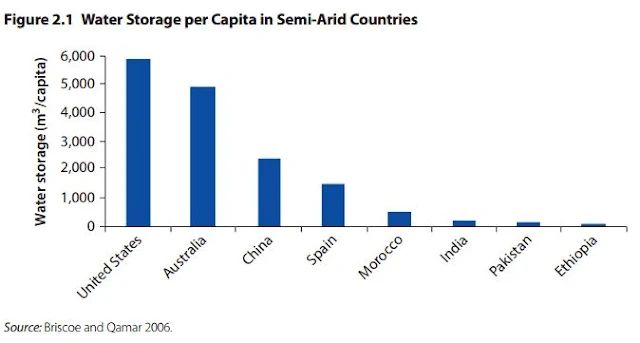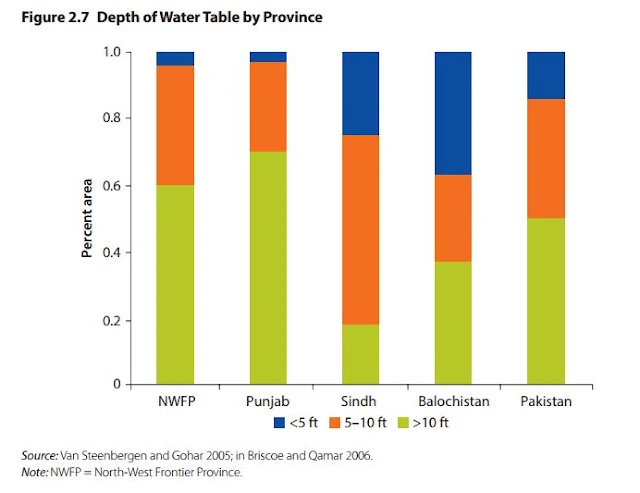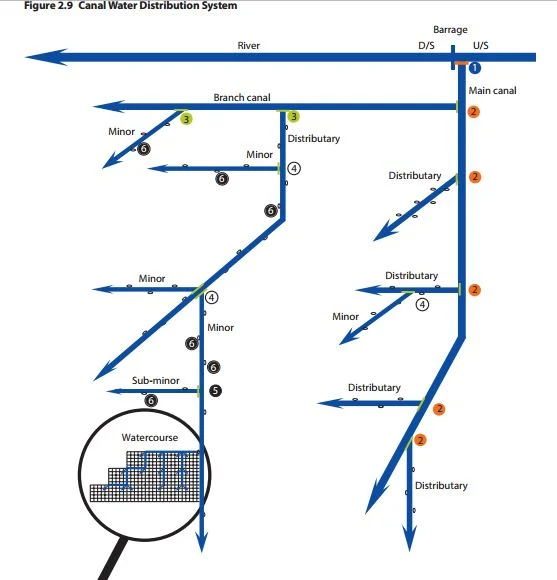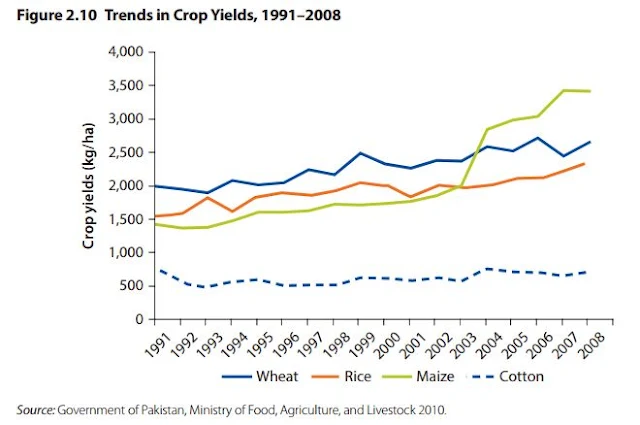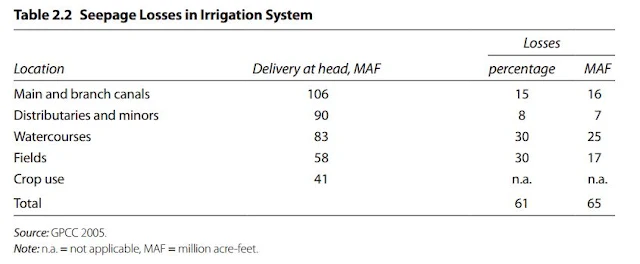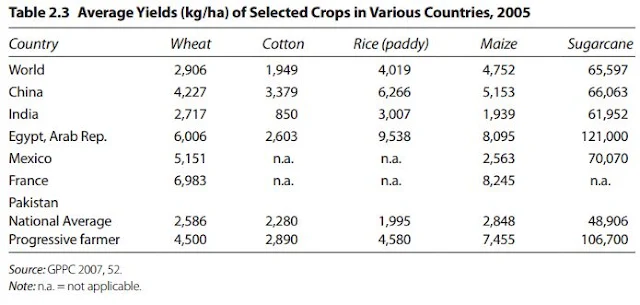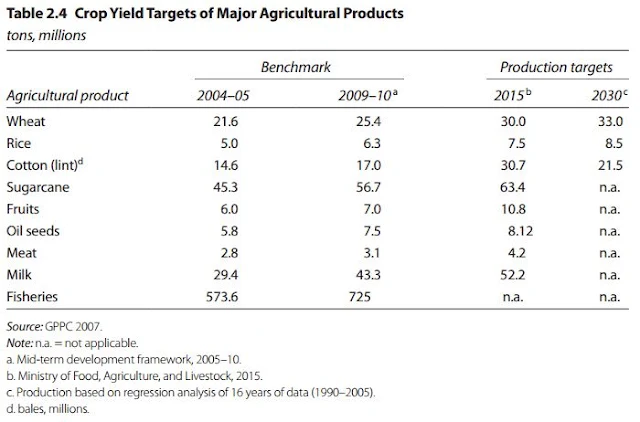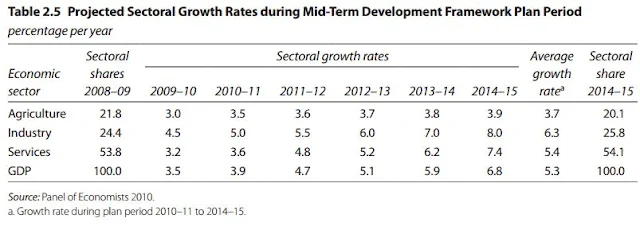The Indus Basin Irrigation System (IBIS) has undergone profound changes and experienced increasing stresses in recent years. Several recent studies have heightened awareness of Indus water resources issues, notably the World Bank study Pakistan’s Water Economy: Running Dry (Briscoe and Qamar 2006).[1] That study convened a team of experts to identify broad challenges and strategic choices facing the water sector in Pakistan.
By The World Bank
James Wescoat, Dario Debowicz, and Sherman Robinson.
Key Messages
• Multi-year storage in the Indus Basin
remains limited.
• Water and food demands are likely to
increase on a per capita basis and in aggregate terms, as population increases.
Reliance on groundwater resources will continue. Falling water tables and
increased salinity in many places may worsen.
• An array of allocation entitlements
economically constrains the waters available for agricultural production and
coping with climatic risks.
• Low water-use efficiencies and agriculture
productivities are top concerns.
• A common set of water and agricultural
policy challenges is complicated by several dynamic stresses and institutional
shifts, including constitutional devolution from national to provincial
levels.
• Most national and provincial development
plans continue to focus on the role of infrastructure in addressing challenges
of water and food security.
• Recent policy documents highlight the
increasing importance of improving irrigation efficiency, improvement of
yields, and the socioeconomic distribution of development opportunities and
benefits, including food security.
• The important role that water management
plays in the productivity of the agriculture sector is recognized in many
different forums and policy reports. However, these linkages are not always
comprehensively addressed (with systems-based models) in federal and provincial
planning documents and budgets.
The Indus Basin Irrigation System (IBIS) has undergone profound changes and experienced increasing stresses in recent years. Several recent studies have heightened awareness of Indus water resources issues, notably the World Bank study Pakistan’s Water Economy: Running Dry (Briscoe and Qamar 2006).[1] That study convened a team of experts to identify broad challenges and strategic choices facing the water sector in Pakistan.
The key
challenges that this modeling framework will examine in the context of climate
risks are
(1) limited
water storage,
(2)
problematic trends in surface water and groundwater use,
(3) inflexible
and uncertain water allocation institutions, and
(4) low
water-use efficiencies and productivity.
Limited Water
Storage:
It is well known that South Asian countries have a lower proportion of water storage and hydro-power development than other regions of the world, both in relation to their geographical potential for storage and power generation and in relation to per capita water and energy use (figure 2.1).
No major reservoir storage projects have been constructed since the completion of Tarbela Dam in 1976, and the system does not have multi-year carryover storage. The total storage is about 11 million acre-feet (MAF), representing about 10 percent of the total inflow in the system.This storage total is likely to decline with increased sedimentation into these reservoirs. This may constrain the quantity and timing of water releases for canal irrigation, and could have the greatest economic impact on the agricultural sector (Amir 2005a, 4). Moreover, figure 2.2 shows how storage per capita is likely to decline with continued population growth. Historically, reservoirs in Pakistan have been operated first for their irrigation benefits, and secondarily for their hydropower generation benefits. Interestingly, there appears to have been a major shift in sector benefit ratios. Work by Amir (2005b) suggests that the hydropower benefits of proposed dams at Basha and Kalabagh are estimated to be substantially greater than their irrigation benefits. The benefits from flood control are estimated to be even smaller. Amir (2005a) qualifies this generalization by noting that
(1) Tarbela
Dam has provided 22 percent of the surface irrigation deliveries in Punjab
alone and has had substantially greater agricultural benefits than predicted,
(2) reservoirs
reduced the variability of water supplies for rabi crops and for delivering
water to eastern canal commands during drought years, and
(3) in wet
years they have helped expand irrigated area and reduce the degree of deficit
irrigation.
The WAPDA 2025
Plan (WAPDA 2004) identifies 22 storage projects in the IBIS. By 2011, some
800+ hydropower projects were identified, which would increase the nation’s
estimated power capacity by some 30 percent (Government of Pakistan Private
Power and Infrastructure Board 2011; Siddiqi et al. 2012). This analysis is
particularly relevant in the wider South Asian regional context where there is
now a “race to the top” to develop new reservoirs throughout the Hindu
Kush-Himalayan region. Although annual flood control benefits are estimated to
be far smaller than those of irrigation or power, they can be periodically
significant, as evidenced by the economic impact of the floods of 2010.ADB and
World Bank (2010) identifies the following key issues related to flood
management:
(1) the
deferred maintenance of flood embankments resulting in structural failures,
(2)
insufficient storage capacity to absorb flood peaks,
(3) lack of
response mechanisms to early warnings,
(4) Need for
expanding flood early warning systems, and
(5)
Encroachment into flood plains and riverine areas.
Post-flood assessments
underscored the imperative of non-structural as well as structural measures,
and their relative and joint significance have yet to be established.
Problematic
Trends in Surface Water and Groundwater Usage
A second area
of concern is the changing relationship between surface and groundwater
irrigation, with the underlying issues of
(1) declining
per capita water availability due to continuing population growth and
(2) increasing
rates of groundwater pumping.
Although the
population growth rate in Pakistan has been declining, it is still 1.8 percent
annually, which portends escalating demand for water, food, and fiber crops
(World Bank 2012b). Even with the relative decline in the population growth
rate, today’s 174 million are projected to be 238 million to 314 million by
2050 (UN Population Division 2012) (figure 2.3). Will land and water resources
suffice for this population? Moreover, water availability per capita has fallen
drastically from 5,650 m3 in 1951 to 1,000 m3 in 2010.And by 2025, this number
is projected to fall to 800 cubic meters (m3) per capita (GPPC 2007), well
below the 1,000 m3 per capita limit below which the supply is defined as “water
insecure” (Falkenmark et al. 2007).
Land use from
the late-19th to early 20th century involved a dramatic shift from a pastoral
landscape punctuated by localized shallow well irrigation to the largest
contiguously managed canal irrigation system in the world (Bedi 2003). By the
second half of the 20th century, private tube-well development had accelerated
(figure 2.4) as a means to reduce water logging and provide a more reliable and
timely water supply for irrigation (Michel 1967). These processes enabled the
reclamation of agricultural land to grow. Cropping intensity also increased in
many areas from one to two crops per year, which has contributed to the
continuing growth of withdrawals for agriculture. More recent data suggest that
tubewell development has been leveling off during the current decade, perhaps
due to increasing pumping costs, unreliable fuel supplies (mainly diesel), and
decreasing groundwater quality.
Irrigated land
increased at an average annual rate of almost 1 percent from 1992 to 2008
(Government of Pakistan, Ministry of Food, Agriculture, and Livestock 2010).
Figure 2.5 shows the change in irrigation source over time (Van Steenbergen and
Gohar 2005). Indeed, most farmers are currently using a combination of canal
and tubewell water, while a smaller proportion relies solely on tubewells. Food
and Agricultural Organization of the United Nations Statistical Database
(FAOSTAT 2012) data estimate groundwater withdrawals at 34 percent of total
withdrawals for all uses, which is probably conservative. Canal irrigation
remains enormously important, though it has been slowly declining as the
predominant source of water. Further opportunities for expanding irrigation
into areas of rainfed (barani) cultivation are limited, although they include
expansion of private tubewell irrigation,watercourse extension,and high-efficiency
irrigation technologies that can operate on uneven terrain (for example, drip
systems). These opportunities vary by province.
Increasing
reliance on groundwater is no doubt related to problems of waterlogging,
salinity, and, in some areas, groundwater depletion. Before an extensive canal
irrigation network was developed in the Indus Basin, it was a land of
monsoon-flooded riparian corridors between the dry upland plains of the great
doabs and deserts. As irrigation historians of the Indus have shown, the
colonial and post-colonial canal system had extensive seepage and spread vast
quantities of water over the land that raised the groundwater table
dramatically (figure 2.6; Gilmartin 1994).
Drawing down groundwater can improve
the waterlogging situation, but it can also increase pumping costs or it can
tap into increasingly brackish waters.
Figure 2.7 shows the particularly high
proportion of shallow groundwater in Sindh province, although it varies across
years. A closer look at recent well records of water table depths shows
significant differences over space and time. In the northern district of
Sialkot in Punjab, for example, where water table levels are relatively high,
water tables have fluctuated between 4 and 16 feet below the surface (figure
2.8). The overall regional pattern shows decreasing water tables, thus
decreased waterlogging, in the basin. To understand the potential impacts on
agricultural production and yields, the variability of water levels and
waterlogging must be compared with changing irrigation patterns and climatic
conditions. The areas affected by waterlogging and salinity have been
monitored, but the costs of this environmental degradation are difficult to
estimate.
A recent study by
Bhutta and Smedema (2005) noted that the direct annual agricultural damage (not
counting the lost opportunities of more profitable land use) is estimated to be
on the order of PRs 20 billion per year. Waterlogging and salinity have also
adversely affected public health and sanitary conditions in the villages. A
more recent national estimate of the economic impacts of salinity on
agricultural production examined two scenarios, one that emphasizes cotton
planting on the most saline lands and the other, wheat. Estimated crop
production losses ranged from PRs 30 to 80 billion in 2004 prices (World Bank
2006, 26). Groundwater quality issues are even more spatially complex and pose
variable threats to agricultural sustainability. Overall salt balance models
have been estimated, but as Ahmad and Kutcher (1992) have shown, the main
challenge is modeling the dynamic spatial distribution and transport of salts
through the irrigation system.As with waterlogging hazards, salinity hazards
tend to accumulate downstream, affecting as much as 50 percent of the land in
Sindh. However, recent village surveys indicate improvements in waterlogging
and salinity in upper Sindh, as contrasted with increasing concerns in the
deltaic region of Badin and Thatta districts (Berger and IAC 2011). Even in
Punjab, salinity conditions vary by sampling well locations within a district
and over time.
Inflexible and
Uncertain Water Allocation Institutions
An array of
entitlements—from individual timeshare water rights (warabandi), to canal
indents, a provincial water accord, and the Indus Waters Treaty (IWT)— shape
the waters available for increasing agricultural production and coping with
climatic risks.While private groundwater pumping is not regulated, surface
water allocation institutions were designed with limited flexibility that
constrain production under conditions of hydroclimatic variability and changing
crop production technologies and functions. Additionally, these inflexible
institutions have been routinely subverted to effect changes that privilege one
group over another, undermine trust, and increase singular perceptions of even
more widespread distortions. Two examples follow.
The canal
water timeshare system is said to have been designed by colonial engineers to
operate continuously under variable flow conditions with minimal involvement of
the irrigators affected (Gilmartin 1994). Outlets (moghas) located on
distributary and minor channels had fixed outlet sizes that were opened and
closed for their respective shares based on farm size and duty of water under
the 1873 Canal Act (figure 2.9). Over time, this system has been increasingly
distorted through the modification of outlet sizes and timings to produce
systematic inequities in waters that are over-allocated at the “head” of a
canal leaving those at its“tail” deprived. Interestingly, Bhatia (2005)
indicates that the presumed benefits of excessive diversions at the canal head
may not always translate into net economic benefits at the canal head, as they
can be offset both by excess water deliveries and less intensive or ineffective
on-farm management. In addition, head-middle-tail inequities vary enormously in
their magnitude and impact on crop
production (Hussain et al. 2003), variations that are sometimes interpreted as
“low yields.”
Indus Water
Accord
Since 1991,
water inflows have been apportioned among the provinces by the Indus Water
Accord. The Accord of 1991 allocated annual flows among the provinces based on
a five-year record of pre-Accord historical canal diversions. The Accord, which
was based on the assumed average flow of 114.35 MAF of water in the Indus
system, allocated 55.94 MAF of water to Punjab and 48.76 MAF to Sindh province,
the remaining 9.65 MAF was divided between North-West Frontier Province (NWFP,
currently known as Khyber Pakhtunkhwa) and Balochistan provinces (Mustafa and
Wrathall 2011). Table 2.1 shows the minimum lump sum allocations across the cropping
seasons.
Any surplus
waters in a given year are distributed according to the following percentages:
• Punjab 37
per cent
• Sindh 37 per cent
• Balochistan
12 per cent
• NWFP (Khyber Pakhtunkhwa) 14 per cent
The Indus
River System Authority (IRSA) was set up by the Accord of 1991 to manage
provincial water demands for reservoir releases and distribution to canal
commands. The “Council of Common Interests,” was introduced in the 1973
Constitution and reconstituted in 2009. It takes up disagreements among the
provinces. IRSA does not have effective structures or mechanisms for regulating
its political representation and technical administrative roles; the former is
sometimes perceived to dominate the latter. In 2010, IRSA faced rising tensions
leading to resignations and near-dissolution of its membership. Provinces have
full authority to allocate their apportioned waters to various canal commands
within their boundaries, which they do on a 10-daily operating basis.
Few major
canal commands cross provincial boundaries (though significant river flows,
groundwater discharge, and drainage flows do cross provincial boundaries).
While the Accord provides for excess flows and redistribution within provinces,
it does not provide for extremely low flow conditions or negotiated transfers
among provinces. A key analytical question is: How do these institutional
constraints affect agricultural production patterns, values, and efficiencies?
Low Water-Use
Efficiencies and Productivity
Low water-use
efficiency and agricultural productivity are top concerns for the Government in
Pakistan. Frequent comparison between low irrigated crop yields in Punjab,
Pakistan, and Punjab, India (Ahmad 2005) find that both regions have lower
yields compared to elsewhere (table 2.3). These comparisons are striking, but
they are not as simple as they appear. Figure 2.10 shows that there has been
slow growth in the overall trends in crop yields from 1991 to 2008 for all but
maize. This may reflect a wide range of agronomic, economic and technological
factors.To what extent are yield differences based on water allocation
differences, as compared with other inputs and resource conditions?
Low water-use
efficiencies raise a comparable question. Efficiencies in the IBIS system
comprise canal efficiencies, watercourse efficiencies, and field efficiency,
measured as a percentage of water delivered relative to the amount withdrawn.
When multiplied, they give a measure of system-wide water-use efficiency.
Typical losses in Pakistan are shown in table 2.2.
Some irrigation scientists
argue that subsequent reuse through pumping of canal seepage should be added,
which would lead to higher estimates of system efficiency (Jensen 2007). Others
argue for a shift from physical water-use efficiency to water productivity,
measured either in terms of quantity of crop produced per cubic meter diverted
and delivered, or in terms of the net caloric or economic value of that crop
per unit of water (Molden et al. 2010).There are many ways to increase water
productivity, from established techniques of watercourse improvement, precision
leveling, and on-farm water management, to substitution of high-efficiency drip
and sprinkler irrigation technologies for some crop and land types, as well as
shifts to new crop types, varieties, and cultural practices. In a large system
like the Indus, these alternatives have complex spatial as well as
technological and economic linkages that need to be addressed through
quantitative modeling.
National
Policies and Plans on Water and Agriculture
National
policies affect all sectors related to Indus Basin management. Of particular
relevance are a recent constitutional change and a suite of long-term and
short-term economic plans and budgets.These plans have had to address volatile
economic and political conditions. During the past decade, Pakistan’s real rate
of gross domestic product (GDP) growth increased from 2 percent in 2001 to 9 percent
in 2006 as a result of a combination of economic reforms, the end of a
multiyear drought, and increased foreign funding related in part to the
conflict in Afghanistan. Increased growth reflected a combination of
international and domestic factors. Pakistan took on a large international debt
position during this period, which made it vulnerable to shocks such as the
Kashmir earthquake in 2005, the global food price spike in 2008, and the
ensuing economic recession, and Indus floods of 2010—all of which contributed
to the drop in GDP growth rate to 2.7 percent by mid-2011 (World Bank 2012b).
An IMF (2010) standby agreement extension strives to manage debt, in part
through fiscal policies such as increasing tax revenues, privatization, and
lowering subsidies. International economic pressures, coupled with domestic and
international security problems, have eroded funding for water and agricultural
development.
Constitutional
Change
The 18th
amendment to the Pakistan Constitution, passed in April 2010, eliminated the
concurrent list of federal and provincial responsibilities and devolved most of
the functions on that list to the provincial level. These functions include
agriculture, including livestock and dairy; environment; and water management.
As an autonomous
federal body, the Water and Power Development Authority (WAPDA) remains at the
federal level, albeit with responsibilities limited to large water
infrastructure planning, construction, and operations. As the Pakistan
Meteorology Department (PMD) is under the Ministry of Defense, it also remains
at the federal level.This constitutional change means that assessments of
climate impacts and adaptation must devote increased emphasis on provincial
planning, management, and governance. Further devolution of water management
responsibilities to local government bodies has been attempted during the past
decade and may resume in the future.
National
Economic Long-Term Planning
The current
long-term plan for Pakistan is titled Vision 2030 (GPPC 2007). Its chapter on
“Agricultural Growth: Food,Water and Land” includes major sections on
agricultural production, water management, food security, and climate
change—the first time this suite of sectors has been jointly addressed in a
long-term planning document for Pakistan. Vision 2030 begins with the
observation that Pakistan has low rates of agricultural productivity, measured
in yield-per-ha, compared with peer producers of food and fiber crops (table
2.3)
Vision 2030
proposes to address these gaps and minimize the impact of climate change in
part by embracing the “gene revolution” (GPPC 2007, 53). Therefore, it is
important to ask how crop breeding may affect water demand and, conversely, how
hydro climatic change could affect the productivity of new varieties. These
uncertainties lie beyond current modeling capability and this report but may be
an area for future investigation. At the same time, while Vision 2030’s
projected crop yields increase relatively steeply between 2005 and 2010, but
flatten out over the next 20 years (table 2.4), the question is whether these
targets are sufficient to meet food demands, given the future population
demands and potential climate change impacts. This question is addressed in
subsequent chapters on modeling.
Finally, the
Vision 2030 report—using the threshold of 1,000 m3/capita after 2010 and
assuming a persistent high population growth rate—argues that an additional 12
MAF of storage is needed. This also incorporates the current observed reservoir
sedimentation and future projections of increased general circulation model
(GCM) monsoon rainfall of 20–30 percent.
Similarly, a
panel of economists submitted recommendations for the next Medium-Term
Development Imperatives and Strategy for Pakistan for a five-year period,
2010–2015.5 The “Panel of Economists Final Report” (2010) envisions the
agricultural growth rate to average only 3.7 percent, due in part to water
constraints (table 2.5). The report urges increased irrigation efficiency,
which it describes as averaging only 37 percent (due to canal, watercourse, and
field losses). It criticizes the fiscal shortfalls of an irrigation revenue
system (abiana) that recovers only 35 percent of its operation and maintenance
costs.The report further recommends accelerated adoption of Bt cotton to
emulate India’s dramatic increase in yields in Bt cotton since 2002. The panel
also advocates preparing for climate change, though it does not draw upon any
current research or make specific policy recommendations.
Note that the
previous mid-term development framework (MTDF)(2005–10) gave more detailed
attention to physical water infrastructure investment. It cited the limited
reservoir storage capacity in Pakistan, storage losses due to reservoir
sedimentation, and irrigation seepage losses that are estimated to be 65 MAF or
61 percent of the water diverted into major canals (table 2.2). Moreover, it
sought to lay out a comprehensive framework for water resources management,
along with support for 36 continuing and 15 new water infrastructure projects,
totaling more than PRs 276 billion over five years.The Agriculture chapter of
the MTDF, by comparison, makes limited reference to issues of water management,
which reflects a sector gap between irrigation and agricultural policy.
Current
federal economic plans and budgets shed light on a number of policy issues
relevant for addressing climate risks, water, and food security in the near
term.There is increasing recognition of climate change issues in federal
planning, but no climate policy has been included in an annual or five-year
development plan or budget to date. A climate change strategy was approved by
the Federal Cabinet in January 2012, and a new Ministry of Climate Change was
created in March 2012 that could guide future planning and budgeting. The
strategy gave heavy emphasis to adaptation in the water, agriculture and
livestock, forestry, disaster preparedness, and vulnerable ecosystems
(mountains, coastal zone, rangelands, wetlands), and human health. It also
includes a mitigation section focused on energy,transport, and industries.
Despite this emphasis, current development plans do not indicate where climate
change risks would be addressed at the federal level. The Pakistan Planning
Commission needs to consider alternative agency and inter-agency organization
for climate change policies and programs.
The Planning
Commission and Ministry of Finance will also need to consider the linkages
between climate change and disaster risk reduction policies. Devolution of
former federal sectoral functions to the provinces under the 18th Amendment
will require stronger policy linkages between the federal water sector and
provincial agricultural sectors. This will require vision and budget support at
the federal level.
National Water
Policies
The primary
policy document in the water sector at the federal level is the WAPDA Vision
2025, developed in 2001, which describes WAPDA’s long-term infrastructure
development plan. Proposed water projects are described on the WAPDA web pages
and are almost entirely physical infrastructure projects (no reference to
climate change). The written report, updated in 2004, presents the overall
context and rationale for these projects. WAPDA has prepared a “Developmental
Plan” that focuses on strategic issues and infrastructure completed, planned,
and phasing; it makes no reference to climate change. A major Water Sector
Strategy was drafted in 2002, and adopted in 2005, but still remains in draft
form. Thus, there is no strong policy linkage between WAPDA’s Vision 2025 for
reservoir and hydropower infrastructure investment at the national level to
increase storage and hydropower capacities, on the one hand, and the various
provincial water sector policies that must address issues of water demand
management and agricultural productivity, on the other.
National water
policy is articulated in the Annual Plans of the Planning Commission and
budgets of the Ministry of Finance. The most recent Annual Plan 2011–2012
introduced the “Water Resources” sector as a balanced program of supply
augmentation and irrigation management. The water sector plan and budget for
2010–11 had ambitious aims that had to be dramatically scaled back due to the
2010 flood and budget cuts. Quantitative targets in the two most recent plans
indicated declining physical achievements and targets both before and after the
2010 flood. Although the plans indicated a partial shift from large projects to
small- and medium-size projects, there are continuing efforts to advance
Basha-Diamer and other large storage and hydropower projects central to WAPDA’s
Vision 2025.
Task Force on
Food Security
The 2008 spike
in world food prices led the Government of Pakistan to set up a Task Force on
Food Security, which delivered its final report in 2009 (GPPC 2009). Its key
points are that Pakistan needs to develop:
(1) a national food security strategy
(supported by 4 percent annual agricultural growth rate, efficient and
equitable storage and pricing, increasing food access through a pro-poor growth
and employment, and transparent safety nets);
(2) a food security index for monitoring
purposes;
(3) favourable
terms for agricultural trade and increased agricultural credit;
(4)
capacity-building in the federal [now provincial] agricultural departments; and
(5)
legislation in the form of a Seed Act Amendment Bill and Plant Breeders Rights
Bill.
The task force
recommendations focus on agricultural growth through increased yields, a shift
to higher value horticultural crops, and increased investment in the high-value
livestock and dairy sector. Attention was also given to enhancing agricultural
water management and water-use efficiency through precision land leveling, watercourse
improvements, water-efficient irrigation technologies, low delta water crops,
and promotion of water saving technologies like drip and sprinkler irrigation.
The report identified water as a major constraint in agriculture. A serious
structural and administrative barrier to achieving the production targets set
in the report is the stressed irrigation system, which is stressed due to
inadequate maintenance and inefficient water use that adversely affects the
water balance. Water shortages are particularly severe in the southern part of
the country where irrigation has expanded into some of the driest regions. The
non-economic water prices also provide no incentive to adopt recommended
cropping patterns and water-saving techniques. Although the national water
policy provides a legal framework for water pricing and cost recovery to ensure
effective and efficient water management, its implementation is poorly managed.
The inefficient use of water was cited as one of the major issues in the
comparably low levels of crop productivity—Pakistan’s cereal production of 0.13
kg per cubic meter of irrigation water compares unfavorably with 0.39, 0.82,
1.56, and 8.7 kg in India, China, the United States, and Canada, respectively
(Kumar 2003). The task force further recommended a two-pronged strategy for the
development of water resources to attain and sustain food security in Pakistan.
First, attention should be paid to reducing water losses and improving
conservation of available water resources to enhance productivity and increase
cropping intensity. This task should include the continuity of ongoing
development projects (watercourse improvement and high-efficiency irrigation
systems), and expanding the coverage of new initiatives and pilot activities, such
as laser land leveling and permanent raised bed, furrow irrigation. Second, new
small-scale irrigation facilities in rain-fed areas and poverty pockets of
fragile eco-zones should be developed. It is estimated that the present cropped
area of 58.5 million acres can be increased by at least 12 million acres from
the available culturable wastelands of 20.6 million acres in the country.
Task Force on
Climate Change
The Government
of Pakistan Planning Commission set up a Task Force on Climate Change in
October 2008 to provide appropriate guidelines for ensuring the security of
vital resources such as food, water, and energy. Their final report, drafted in
February 2010 (GPPC 2010), contributed to the formulation of a climate change
policy that has been helping the Government pursue sustained economic growth by
addressing the challenges posed by climate change. The report acknowledged the
limited scope for expanding water supplies and advised that Pakistan would have
to improve the efficiency of water use in all the sectors, particularly in
agriculture. It also warned of the risk of increased demand of irrigation water
because of higher evaporation rates at elevated temperatures in the wake of
reducing per capita availability of water resources and increasing overall
water demand. The report predicted that the impacts on food security in the
agriculture sector would mainly be through reduced crop productivity caused by
extreme events (floods, droughts, and cyclones). Given these risks under the
increasing pressure of a growing population, Pakistan has no option but to take
major steps for increasing its land productivity and water-use efficiency.
About The Authors:
Winston Yu, Yi-Chen Yang, Andre Savitsky, Donald Alford, Casey Brown, James Wescoat, Dario Debowicz, and Sherman Robinson.
Cite This Article:
Yu, Winston,
Yi-Chen Yang, Andre Savitsky, Donald Alford, Casey Brown, James Wescoat, Dario
Debowicz, and Sherman Robinson. “The Current Water and Agriculture Context,
Challenges, and Policies.” The Impacts of Climate Risks on Water and
Agriculture (April 18, 2013): 35–55. © International Bank for Reconstruction
and Development/The World Bank
Publication Details:
This is a Chapter No:#2 The Current
Water and Agriculture Context, Challenges, and Policies in the book "The Indus Basin of Pakistan: The Impacts of Climate Risks on Water and Agriculture"
(http://dx.doi.org/10.1596/9780821398746_CH02) published under a Creative Commons License 3.0 IGO and is available for download at DSpace@MIT, A part of MIT Open Access Article Repository | ISBN: 978-0-8213-9874-6 / ISSN: 978-0-8213-9875-3 |
References:
ADB (Asian
Development Bank) and World Bank. 2010. “Pakistan Floods 2010 Damage and Needs
Assessment.” Pakistan Development Forum, Islamabad, November 14–15.
Ahmad, M., and
G. P. Kutcher. 1992. “Irrigation Planning with Environmental Considerations: A
Case Study of Pakistan’s Indus Basin.” World Bank Technical Paper 166, World
Bank, Washington, DC.
Ahmad, S.
2005. “Water Balances and Evapotranspiration.” Background paper for Pakistan’s
Water Economy: Running Dry. Washington, DC: World Bank and Oxford University
Press.
Amir, P.
2005a. “Modernization of Agriculture.” Background paper for Pakistan’s Water
Economy: Running Dry. Washington, DC: World Bank and Oxford University Press.
———. 2005b. “The Role of Large Dams in the Indus Basin.” Background paper for
Pakistan’s Water Economy: Running Dry. Washington, DC: World Bank and Oxford
University Press.
Bedi, Baba
Pyare Lal. 2003. Harvest from the Desert. The Life and Work of Sir Ganga Ram.
Lahore, Pakistan: NCA.
Berger, L. I., and IAC. 2011. “Preparation of
Regional Plan for the Left Bank of Indus, Delta, and Coastal Zone for the Sindh
Irrigation and Drainage Authority.” http://
www.sida.org.pk/download/lbg/phaseIII/Volume%20I%20&%20II%20-%20Draft. pdf.
(accessed January 28, 2013).
Bhatia, R.
2005. “Water and Growth.” Background paper for India’s Water Economy: Bracing
for a Turbulent Future. Washington, DC: World Bank and Oxford University Press.
Bhutta, M. N.,
and L. K. Smedema. 2005. “Drainage and Salinity Management.” Background paper
for Pakistan’s Water Economy: Running Dry. Washington, DC: World Bank and
Oxford University Press.
Blackmore, D.
and F. Hasan. 2005.“Water Rights and Entitlements.” Background paper for
Pakistan’s Water Economy: Running Dry. Washington, DC: World Bank and Oxford
University Press.
Briscoe, J.,
and U. Qamar, eds. 2006. Pakistan’s Water Economy: Running Dry (includes CD of
background papers, 2005). Washington, DC: World Bank.
Falkenmark,
M.,A. Berntell,A. Jägerskog, J. Lundqvist, M. Matz, and H.Tropp. 2007.“On the
Verge of a New Water Scarcity: A Call for Good Governance and Human Ingenuity.”
SIWI Policy Brief. Stockholm International Water Institute, Stockholm.
FAOSTAT (Food
and Agricultural Organization of the United Nations Statistical Database). 2012.
Database of Food and Agriculture Organization of the United Nations, Rome. http://faostat.fao.org/.
Gilmartin, D.
1994. “Scientific Empire and Imperial Science: Colonialism and Irrigation
Technology in the Indus Basin.” Journal of Asian Studies 53: 1127–49.
Government of
Pakistan, Ministry of Food, Agriculture, and Livestock. 2010. Agricultural
Statistics of Pakistan 2008–2009. Islamabad.
Government of
Pakistan, Private Power and Infrastructure Board. 2011. Hydropower Resources of
Pakistan. Islamabad. http://www.ppib.gov.pk/hydro.pdf.
GPPC
(Government of Pakistan, Planning Commission). 2005. Medium-Term Development
Framework, 2005–2010. “Chapter 27: Water Resources”, Table 5. Islamabad.
http://pc.gov.pk/mtdf/27-Water%20Sector/27-Water%20Sector.pdf.
———. 2007.
Vision 2030, “Chapter 6: Agricultural Growth: Food, Water and Land.” Islamabad.
http://www.pc.gov.pk/vision2030/Pak21stcentury/vision%202030-Full.pdf.
———.
2009. Final Report of the Task Force on Food Security. Islamabad.
———. 2010.
Task Force on Climate Change Final Report. Islamabad.
Hussain, I.,
R. Sakthivadivel, U. Amarasinghe, M. Mudasser, and D. Molden. 2003. Land and
Water Productivity of Wheat in the Western Indo-Gangetic Plains of India and
Pakistan: A Comparative Analysis. Research Report 65, International Water
Management Institute, Colombo.
IMF
(International Monetary Fund). 2010. Pakistan: Fourth Review Under the Stand-By
Arrangement, Requests for Waivers of Performance Criteria, Modification of
Performance Criteria, and Rephasing of Access. Staff Report; Staff Statement
and Supplement; Press Release on the Executive Board Discussion; and Statement
by the Executive Director for Pakistan. IMF Country Report 10/158. Washington,
DC (accessed October 21, 2012). http://www.imf.org/external/pubs/ft/scr/2010/cr10158.pdf.
Jensen, M. E.
2007.“Beyond Irrigation Efficiency.” Irrigation Science 25(3): 233–245.
Kumar, M. D.
2003. “Food Security and Sustainable Agriculture in India: The Water Management
Challenge”. Working Paper 60, International Water Management Institute,
Colombo, Sri Lanka.
Michel, A. A.
1967. The Indus Rivers: A Study of the Effects of Partition. New Haven, CT:
Yale University Press.
Molden, D.,T.
Oweis, P. Steduto, P. Bindraban, M.A. Hanjra, and J. Kijne. 2010.“Improving
Agricultural Water Productivity: Between Optimism and Caution.” Agricultural
Water Management 97 (4): 528–35.
Mustafa, D.,
and D. Wrathall. 2011. “Indus Basin Floods of 2010: Souring of a Faustian
Bargain.” Water Alternatives 4 (1): 72–85. Panel of Economists. 2010. Final
Report, Panel of Economists, Medium-Term Development Imperatives and Strategy
for Pakistan.
Government of
Pakistan, Planning Commission, Islamabad. http://pide.org.pk/pdf/Panel_of_Economists.pdf.
Siddiqi, A.,
J. Wescoat, S. Humair, and K. Afridi. 2012. “An Empirical Analysis of the
Hydropower Portfolio in Pakistan.” Energy Policy 50 (November): 228–41. United
Nations Population Division. 2012. “Population Prospects.” http://esa.un.org/
unpd/wpp/unpp/panel_population.htm.
Van
Steenbergen,F., and M.S.Gohar.2005.“Groundwater Development and Management in
Pakistan.”Background paperfor Pakistan’s Water Economy: Running Dry.Washington,
DC: World Bank and Oxford University Press.
WAPDA (Water
and Power Development Authority). 2004. Water Resources and Hydropower
Development Vision—2025 (Revised). Government of Pakistan Water and Power
Development Authority, Lahore.
Wescoat, James
L., Jr., S. Halvorson, and D. Mustafa. 2000. “Water Management in the Indus
Basin of Pakistan: A Half‑Century Perspective.” International Journal of Water
Resources Development 16 (3): 391–406.
World Bank.
2006. Pakistan Strategic Country Environmental Assessment, vol. 2, Technical Annex:
The Cost of Environmental Degradation in Pakistan—An Analysis of Physical and
Monetary Losses in Environmental Health and Natural Resources. Report 36946-
PK. World Bank, Washington, DC.
———. 2012a. “Indus Waters Treaty.”
http://web.worldbank.org/WBSITE/EXTERNAL/
COUNTRIES/SOUTHASIAEXT/0,contentMDK:20320047~pagePK:146736~piPK:
583444~theSitePK:223547,00.html.
———. 2012b. World Development Indicators
Databank (WDI). Online database. http://
databank.worldbank.org/ddp/home.do?Step=12&id=4&CNO


